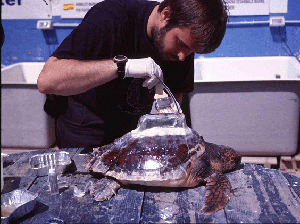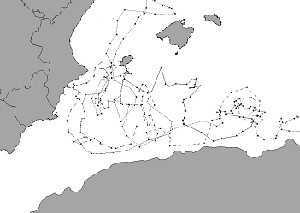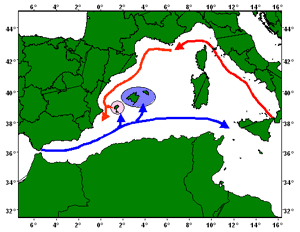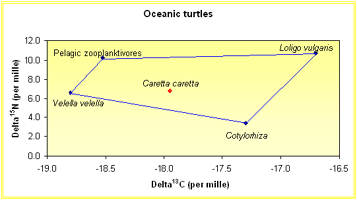Aims:
The aim of Action F-6 was to draw up a conservation
plan for the Loggerhead Turtle ( Caretta Caretta) in SCI areas round
and near the Balearic Islands. Three specific priorities were identified
in the proposal: (1) to establish the medium and long-term movements of
individuals present in the area, as well as their distribution, seasonality
and origin, (2) to estimate the size of the population and (3) to quantify
the effect of the number of catches by professional fishing in the Balearics.
Methods applied:
Movement, distribution, seasonality and origin of the individuals.
In order to evaluate the populations of common dolphin (Action F.7) and
loggerhead turtle (Action F.6), three flight campaigns were undertaken
which covered the whole of the seaboard of the Balearic Archipelago. The
third campaign, which covered the channels between islands did not yield
relevant data on turtles and is therefore not included in this section.
Between April 2003 and November 2004, a total of 12 turtles were hand-captured
in the Balearics in order to fit them with transmitters emitting signals
to satellites (Telonics, models ST-18 and ST-20), which operate through
the Argos system (2000). The Marineland-Palmitos Foundation ceded another
three individuals from their recovery centre. The turtles were monitored
for a period of time varying from two to twelve months.

Figure 6.1: Fitting a satellite transmitter.
The samples collected by the Network for the Control of Beached Animals pertaining to the Consellería de Medio Ambiente (Local Ministry of the Environment), yielded 137 samples of skin, fat, shell, muscle and bone, for genetic analysis and for the analysis of stable isotopes, as well as 19 samples of stomach content to be analysed. The IsoSource mix model was used for the food study in order to calculate the contribution made by 24 potential prey to the turtles’ diet. In order to establish the origin of the turtles present round the Balearic Islands it was necessary to study the genetic profile of the individuals found there as well as that of those found in nesting areas of the eastern Mediterranean ( the profile of individuals at Atlantic nesting areas had already been studied previously). This study was carried out in collaboration with several different entities, among them: CRAM (Spain), Archelon (Greece), Medasset (Greece), Adnan Menderes University (Turkey), Naucrates (Italy), Stazione Zoología A. Dohrn (Italy), The Nature & Parks Authority of Israel and the Tel-Aviv University (Israel). A fragment of 391pb of the control region of the D-loop of the mitochondrial DNA was used as genetic marker, as well as seven micro-satellites of nuclear DNA.
Population size.
The size of the population was determined by aerial census count combined
with satellite monitoring and the analysis of the data obtained by means
of capture/marking/re-capture. Data provided by the flights and the transmitters
described above, capable of registering the time the animal spent on the
surface, were used. Further to this, during 2003 and 2004, 32 animals
were fitted with metallic marks, although none of the animals were later
re-captured and for this reason this method was considered as not very
useful. In the census counts carried out during the flight campaigns an
average of 18.5 + 3.5 individuals were observed per campaign. On the other
hand, animals followed by satellite spent 9.7 % of the time monitored
on the continental seaboard of the Balearics, remaining on the surface
18.5 % of the time. The flight census counts covered a surface of 329.03
square kilometres ( 1,645.15 km were travelled x =.2 km width, of a total
of 7,773.7 sq. km).
Impact of professional fishing
To evaluate the effect that professional fishing has on the turtle population
found in Balearic waters, two complementary techniques were combined:
surveys were carried out in which fishermen had to provide answers to
questionnaires, and observers were sent on board fishing boats. Results
provided by the observers were compared to those that the questionnaires
carried out at ports yielded. A total of 162 questionnaires were filled
in, covering 32.9 % of the fleet of professional fishing boats. When compared,
it was seen that there was not a significant difference between data obtained
by the observers and data gleaned from the questionnaires so the veracity
of said data was assumed. Once said veracity was checked, it was assumed
that the same sort of situation was also happening in the rest of the
archipelago and the total number of captures were quantified from the
data gleaned from the questionnaires. Declared captures totalled 143 turtles
and were carried out by 33 ships. Seven of the thirteen modes of fishing
practised round the island were implicated in the capture of these turtles.
Results.
Movement, distribution, seasonality and origin of the individuals.
The combined analysis of information obtained through flight campaigns
and satellite monitoring of the animals revealed the following:
1) Turtles are randomly distributed throughout the continental seaboard of the Balearics.
2) There is an absence of seasonal latitudinal migration.
3) The area covered by the turtles is limited to the Algerian Basin although there are brief stays in the Catalan- Balearic sea.
4) The species prefers ocean water.

Figure 6.2. Tracking of some of the turtles fitted with satellite transmitters.

Figure 6.3: Migration routes followed by Loggerhead turtles in the western Mediterranean
In the analysis of stable isotopes no statistic differences
were observed between turtles captured in ocean water (d13C: -17.9 ±
0.4 0/00 y d15N: 6.8 ± 0.6 0/00) and turtles captured in neritic
waters (d13C: -18.5 ± 0.4 0/00 y d15N: 6.1 ± 0.9 0/00),
and therefore the conclusion is that there are not two different populations.
The genetic analysis revealed that the haplotype frequencies found in
the Balearics differ significantly from those observed in Catalonia, Tyrrhenian
Sea, and Jonic Sea, but do not differ from those observed in Andalusia,
The Azores, Madeira and Lampedusa.
These results suggest that the Balearic Islands receive a very limited
contribution from the nesting beaches of the Eastern Mediterranean, equivalent
to what happens in Madeira and The Azores (Bolten et al. 1998). On the
other hand, important differences have been observed when comparing the
allelic frequencies coming from the seven micro-satellites on turtles
of Atlantic haplotypes with the frequencies coming from Mediterranean
nesting beaches. This allows us to use the micro-satellites in order to
calculate the most probable nesting area from which a turtle (of a haplotype
common to both the Mediterranean and Atlantic) is coming. The use of this
method has revealed that 90 % of the turtles present in the Balearics
come from Atlantic nesting beaches, a result which can be extrapolated
to the whole of the Algerian Basin.
Population Size.
The size of the population of Loggerhead turtle present on the continental
seaboard has been estimated at 2,362.6 + 446.5 turtles , while the approximate
size of the stock to which turtles present on the islands’ seaboard
belong is of 24,356.8 + 4,602.4.
Taking into account the area covered by satellite tracked animals, this
could be the size of the population present in the Algerian Basin.
The impact of professional fishing
Extrapolating the survey results to the whole of the professional fishing
fleet allowed us to estimate the total capture throughout 2001 as being
of 377 turtles (95% CI:365-308). The fishing modes causing the most damage
are surface long-line fishing (102 turtles, 95% CI: 111-93) and the trammel
fishing of spiny-lobster ( 196 turtles, 95% DI: 269-123). In general terms
conservation of the Loggerhead turtle nesting in the eastern Mediterranean
is threatened by the mortality rate along the European coastline of the
Mediterranean and not by the mortality in the Algerian Basin. For this
reason it is necessary to carry out further research in order to identify
the causes of mortality in the first region.
General results of the Action:
The aims of the Action have been fulfilled as the following points were
achieved:
(1)establishing the movements of the turtles in both the medium and long-term,
as well as the distribution of the animals, their seasonality and origin,
(2) estimating the size of the population and (3) quantifying the effect
of turtle capture by professional fishing in the Balearic Islands.
Only the second point (population size) requires further clarification. The satellite tracking revealed that the area covered by turtles on the move found in Balearic waters spans most of the Algerian Basin and one small area of the Catalan-Balearic Sea. On the other hand, aerial turtle monitoring carried out by means of flight campaigns covered only the continental seaboard of the Balearics. It is certainly possible to calculate the fraction of population present at a given moment in this particular area and from there calculate the total number of turtles present in the whole of the Algerian Basin, and this is what was done. Nevertheless, in order to obtain more accurate estimations of the number of turtles present in this last area, it would be necessary to carry out further flight campaigns or census counts from on board ships, both of which should cover a wide area of the Algerian Basin. In the future, this activity should be carried out periodically in order to evaluate the demographic tendency of the population. Using the technique of capture/marking/re-capture does not seem adequate. In spite of the effort, only some dozens of turtles were captured, and none recaptured. These poor results are explained by the fact that the area which moving turtles cover is very large.
The results obtained have made it clear that SCI areas proposed are insufficient to protect Loggerhead turtles, as the species does not spend much time in said areas. The best strategy in order to preserve this species would be to drastically reduce accidental captures as this is the main threat the turtles face. Local authorities in the Balearic Islands ( the Autonomous Government and the Island Councils) have at their hand the possibility of minimizing accidental capture of Loggerhead turtles due to the trammel fishing of spiny-lobsters, as these governmental organizations are in charge of inspecting fishing activities in territorial waters. In contrast, reducing accidental capture of turtles in the Algerian Basin is the responsibility of the Ministry of Agriculture Fishing and Food of the Government of Spain, for it is this Ministry which regulates fishing activities in external waters and stipulates the norms which are to be followed by Spanish boats fishing in international waters. Nevertheless, in order to effectively protect this species it is imperative that other countries whose ships also fish in the area (France, Italy, Morocco and Algeria) take similar protective measures.
Further, this project has also allowed us to deepen our
knowledge of the conservation biology of Loggerhead turtles. Among other
items, the analysis of their diet has established that the species’
staple food is gelatinous zooplankton, although fish and cephalopods contribute
20 % of the carbon assimilated. The analysis of stomach content has confirmed
that benthic prey does not contribute greatly to the diet of Loggerhead
turtles in the Balearics.

Figure 6.4. The contribution of different prey to the diet of Loggerhead turtles in the Balearics.